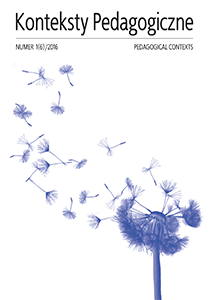Abstrakt
Na wstępie autor przedstawia rozważania nad współczesnymi wyzwa-niami stojącymi przed edukacją przedszkolną. Podkreśla znaczenie stosowania na-rzędzi TOC .w przedszkolu, które zapewniają dobre przygotowanie dziecka do roli ucznia w szkole. W rozwinięciu prezentuje założenia teoretyczne programu TOC (Theory of Constraints). Autor skupia się także na przedstawieniu narzędzi TOC, ta-kich jak: gałąź logiczna, chmurka, drzewko ambitnego celu. Każde z narzędzi opi-sane jest pod kątem efektów, jakie daje w pracy edukacyjnej z dzieckiem. Podkre-ślając walory edukacyjne narzędzi TOC w edukacji przedszkolnej, autor dzieli się własnym doświadczeniem pedagogicznym jako nauczyciel praktyk i trener.
Bibliografia
Białobrzeska J., Zostań nawiedzoną nauczycielką, czyli jak uczyć, żeby nauczyć, Warszawa 2006.
Dolya G., Klucz do uczenia się, przeł. V. Dawidow, Gdańsk 2007.
Donaldson M., Myślenie dzieci, przeł. A. Hunca-Bednarska, E.M. Hunca, Warszawa 1986.
Istance D., Dumont H., Przyszłość środowisk uczenia się w XXI wieku, [w:] Istota ucze-nia się. Wykorzystanie wyników badań w praktyce, red. H. Dumont, D. Istance, F. Be-navides, przeł. Z. Janowska, Warszawa 2013.J
ankowiak-Siuda K., Komorowska M., Ciekawość świata. O pamięci i twórczości małego dziecka, Gdańsk 2010.
Kamińska D., Jak bawić się i uczyć z pasją? Zastosowanie narzędzi myślowych TOC w pracy z dziećmi, Kraków 2012.
Kamińska D., Jak rozwijać umiejętność logicznego myślenia? Zastosowanie narzędzi TOC w przedszkolu, „Bliżej Przedszkola” 2011, nr 9.
Kubiczek K., Metody aktywizujące. Jak nauczyć uczniów uczenia się?, Opole 2009.
Robinson K., Aronica L., Kreatywne szkoły. Oddolna rewolucja, która zmieniła edukację, przeł. A. Baj, Kraków 2015.
Sternberg R.J., Spear-Swerling L., Jak nauczyć dzieci myślenia, przeł. O i W. Kubińscy, Gdańsk 2003.
Śliwerski B., Przedszkole pierwszym centrum aktywnego uczenia się, „Bliżej Przedszkola” 2014, nr 9.
Tkaczyk A., Pokaż dziecku świat symboli. Inspiracje wychowawcze, Kraków 2007.
Autor zgodnie z zaleceniem MNiSW, by przeciwdziałać praktykom „ghostwriting” i „guest authorship” składając tekst dołącza oświadczenie Autora/Autorów, w którym deklaruje wkład każdego z Autorów w powstawanie publikacji. Własnoręcznie podpisane oświadczenie należy przesłać na adres redakcji:
Joanna Skibska | w formie skanu przesłać poprzez system OJS (biblioteka wydawcy).
Autorzy nie ponoszą żadnych kosztów w związku z publikacją artykułu na łamach czasopisma Konteksty Pedagogiczne oraz nie otrzymują gratyfikacji finansowej za opublikowanie tekstu. Redakcja zastrzega sobie prawo do wprowadzania niewielkich zmian w artykułach, które nie mają wpływu na merytoryczną stronę publikacji.
Autor (Autorzy) artykułu oświadcza, że przesłane opracowanie nie narusza praw autorskich osób trzecich. Wyraża zgodę na poddanie artykułu procedurze recenzji oraz dokonanie zmian redakcyjnych. Przenosi nieodpłatnie na Wydawnictwo Libron autorskie prawa majątkowe do utworu na polach eksploatacji wymienionych w art. 50 Ustawy z dnia 4 lutego 1994 r. o prawie autorskim i prawach pokrewnych – pod warunkiem, że praca została zaakceptowana do publikacji i opublikowana.
Wydawnictwo Libron posiada autorskie prawa majątkowe do wszystkich treści czasopisma. Zamieszczenie tekstu artykuły w repozytorium, na stronie domowej autora lub na innej stronie jest dozwolone o ile nie wiąże się z pozyskiwaniem korzyści majątkowych, a tekst wyposażony będzie w informacje źródłowe (w tym również tytuł, rok, numer i adres internetowy czasopisma).
Tekst jest udostępniany w internecie na licencji CC-BY-SA

